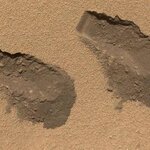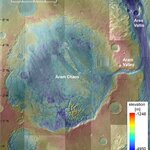Geology

When most people think of the Antarctic, they think of snow, ice and glaciers - but the continent and surrounding waters are littered with fiery volcanoes.
The Marie Byrd Seamounts in the Amundsen Sea are not active, like many volcanoes there are. Their summit plateaus are today at depths of 2400-1600 meters but, because they are very difficult to reach with conventional research vessels, they have hardly been explored.
What is intriguing is that they do not fit any of the usual models for the formation of volcanoes. Now geologists from GEOMAR Helmholtz Centre for Ocean Research Kiel were…

Tiny crystals of zircon, a mineral found in the igneous rock rhyolites, from the Snake River Plain in the Yellowstone hotspot has solidified evidence for a new way of looking at the life cycle of super-volcanic eruptions.
The pattern emerging from new and previous research completed in the last five years is that another super-eruption from the still-alive Yellowstone volcanic field is less likely for the next few million years than previously thought. The last eruption 640,000 years ago created the Yellowstone Caldera and the Lava Creek Tuff in what is now Yellowstone National Park.
The…

Rocky basalt pillars that litter Iceland's Skaelingar valley likely formed in a surprising reaction where lava met water - but without any explosion occurring.
The authors of a new paper say that non-explosive lava–water interactions happened during the emplacement of the Laki lava flow in Iceland during 1783–1784. Skaelingar valley contains a tributary stream to the Skafta River.
"Usually, when lava and water meet in aerial environments, the water instantly flashes to steam," said lead author Tracy Gregg, a University of Buffalo associate professor of geology. "That's a volume increase of…

The earliest evidence of a comet entering Earth's atmosphere and exploding has been found. It rained down a shock wave of fire which obliterated every life form in its path, has been found.
The comet entered Earth's atmosphere above Egypt about 28 million years ago. After it entered the atmosphere, it exploded, heating up the sand beneath it to a temperature of about 2 000 degrees Celsius, resulting in the formation of a huge amount of yellow silica glass which lies scattered over a 6 000 square kilometer area in the Sahara. A magnificent specimen of the glass, polished by ancient…

I can remember a time when I thought of dirt as something that only seemed to change about it was the color. I had noticed it when my family took vacations and even in looking at the soils in my grandparent’s yard since grandmom was an avid composter. But when I moved from Memphis to Enid, Oklahoma, the color change was so stark with the red soils totally disconnecting from the browns I had always called home.
Sure it was before I started working in agriculture, which has been a long time but those memories are clear. It wasn’t until I got to know farmers that I began to understand some…

Geologists and geophysicists have discovered traces of large ice sheets from the Pleistocene on a seamount off the north-eastern coast of Russia, confirming for the first time that within the past 800,000 years in the course of ice ages, ice sheets more than a kilometer thick also formed in the Arctic Ocean.
This makes it possible to write an accurate climate history for this part of the Arctic. They had discovered the first signs of conspicuous scour marks and sediment deposits on the ocean floor north of Wrangle Island (Russia) on a Polarstern expedition in 2008 but they were unable to…

The first rock that scientists analyzed on Mars with a pair of chemical instruments aboard the Curiosity rover turned out to be a doozy – a pyramid-shaped volcanic rock called a "mugearite" that is unlike any other Martian igneous rock ever found.
Dubbed "Jake_M" – after Jet Propulsion Laboratory engineer Jake Matijevic – the rock is similar to mugearites found on Earth, typically on ocean islands and in continental rifts. The process through which these rocks form often suggests the presence of water deep below the surface, according to Martin Fisk, an Oregon State University marine…

NASA's Curiosity Rover has sampled a surprising diversity of soils and sediments along a half-kilometer route during its first few months on Mars. And what it has found tells a complex story about the gradual desiccation of the Red Planet.
Perhaps most notable among findings from the ChemCam team is that all of the dust and fine soil contains small amounts of water.
In a series of papers covering the rover's top discoveries during its first three months on Mars, the rover's ChemCam instrument team up with an international cadre of scientists affiliated with the CheMin, APXS, and SAM…

Deep earthquakes occur where the oceanic lithosphere, driven by tectonics, plunges under continental plates – examples are off the coasts of the western United States, Russia and Japan.
Some new research is a step toward replicating the full power of these earthquakes to learn what sets them off and how they unleash their violence and was made possible only by the construction of a one-of-a-kind X-ray facility that can replicate high-pressure and high-temperature while allowing scientists to peer deep into material to trace the propagation of cracks and shock waves.
The U.S. Department of…

Chaotic terrains are enigmatic features stretching up to hundreds of kilometres across Mars. The mechanism by which they formed is hypothesis and even speculation in most cases.
A recent paper, which combines observations from satellite photos of the 280 kilometere wide and four kilometer deep crater plus models of the ice melting process and resulting catastrophic outflow, says that Aram Chaos, the lumpy, bumpy floor of an ancient impact crater on Mars, formed as a result of catastrophic melting and outflow of a buried ice lake.
Manuel Roda presented the results, done with Tanja E…